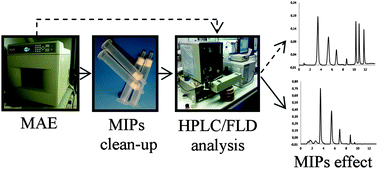Molecularly imprinted polymer-liquid chromatography/fluorescence for the selective clean-up of hydroxylated polycyclic aromatic hydrocarbons in soils
Abstract
Hydroxylated polycyclic aromatic hydrocarbons (OH-PAHs), a group of metabolites produced during the biodegradation of PAHs by microorganisms, are known to be difficult to analyze from complex environmental or biological matrices. In the field of contaminated soils, where OH-PAHs are less studied, a new method was compared to a common method for the analysis of monohydroxylated PAH metabolites: 2-naphthol, 2-hydroxyfluorene, 9-phenanthrol and 1-hydroxypyrene. After optimizing the microwave assisted extraction (MAE) step, the obtained extracts, containing the OH-PAHs together with the corresponding PAHs, were purified by molecularly imprinted polymers (MIPs). MIPs showed an effective selectivity for the hydroxylated derivatives studied (and not for native PAHs), which allowed their identification and quantification by HPLC/FLD. By this method, good limits of detection (0.003–0.014 μg g−1) and limits of quantification (0.010–0.044 μg g−1) were achieved. On the other hand, following the common method, the sample extract was concentrated by evaporation, silylated, and analyzed by GC/MS. The new method was more sensitive for all OH-PAHs and the analysis showed fewer matrix effects due to the use of MIP clean-up. In the present work the advantages and disadvantages of the new method are shown, as well as the possible application to soil biodegradation studies.


 Please wait while we load your content...
Please wait while we load your content...